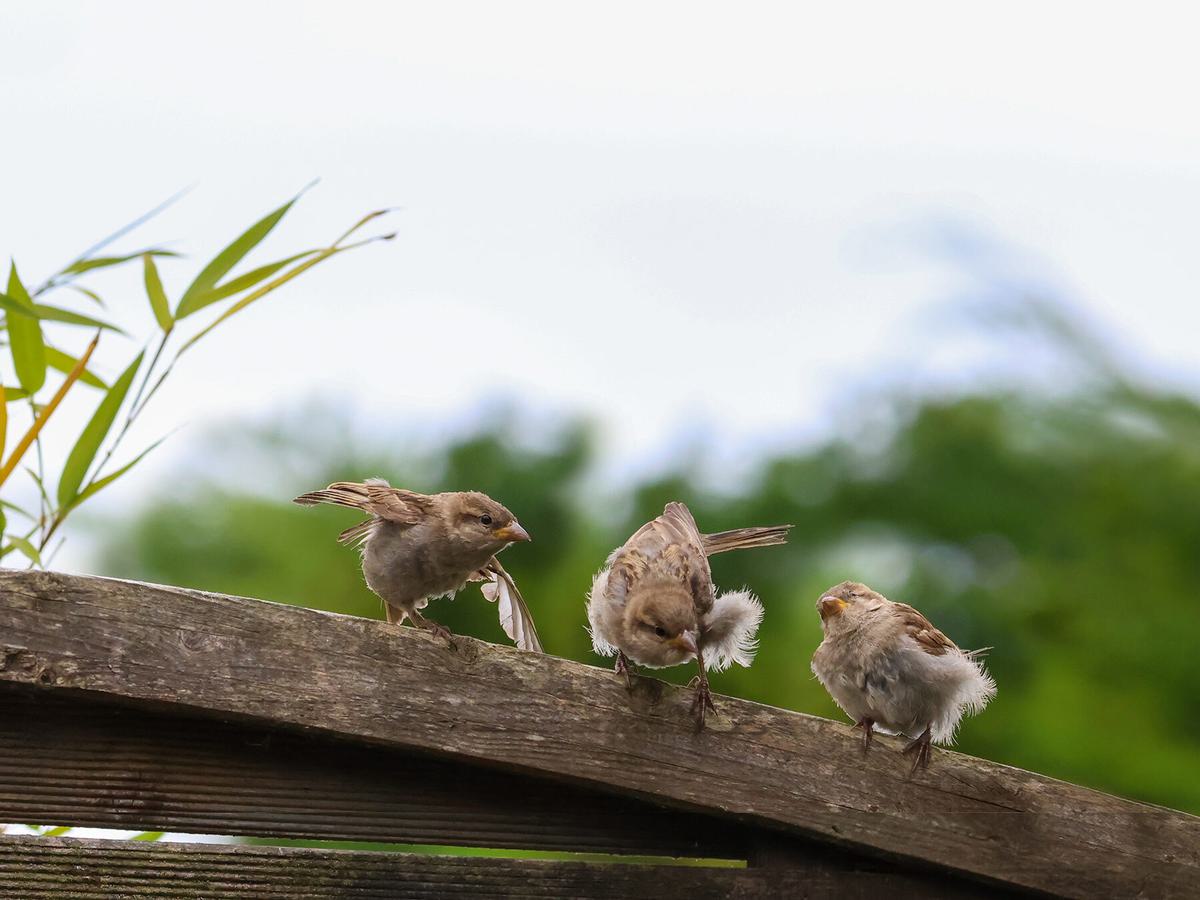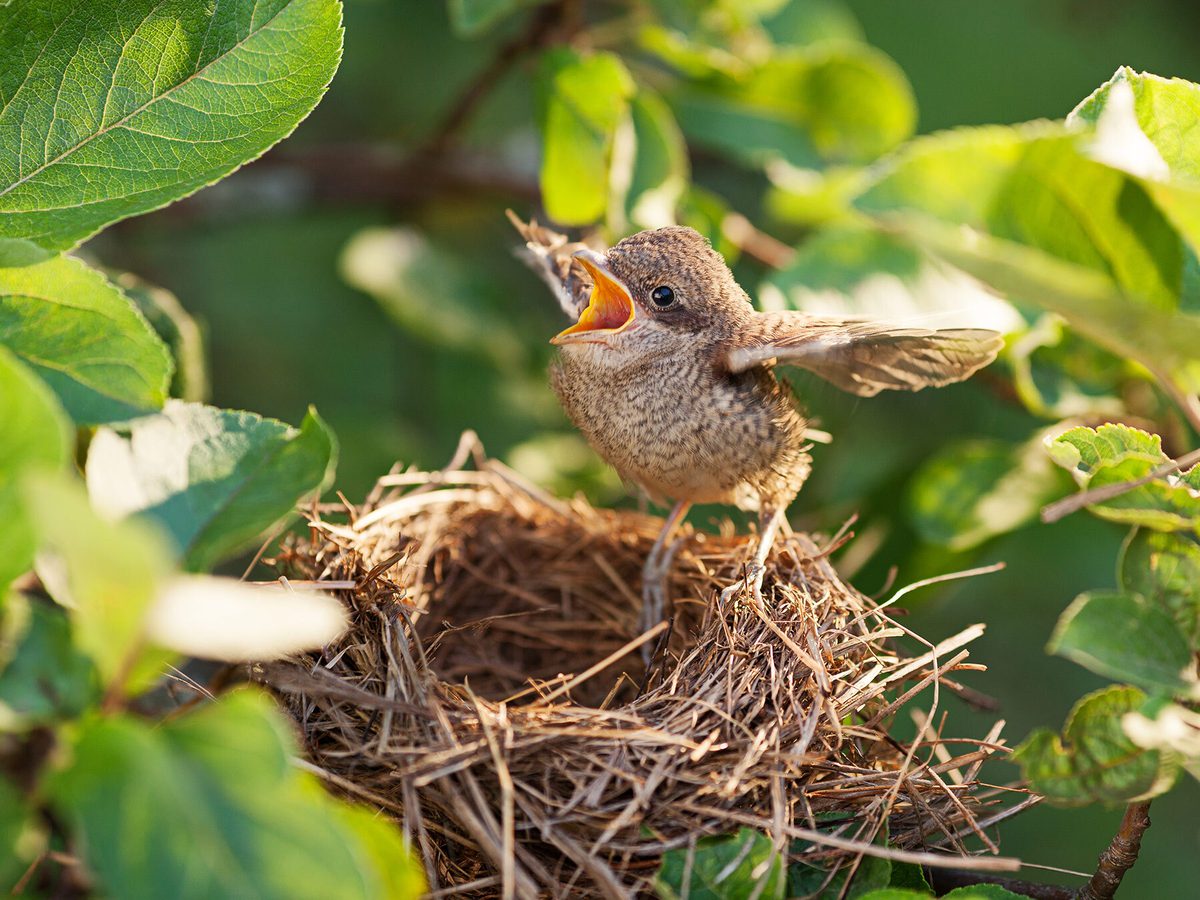Before they can live independently, birds must master the art of flight. In the first few days and weeks of life, birds undergo a rapid transformation, from developing their first flight feathers to taking to the skies for the first time.
But once these feathers are ready and they are physically capable of using their wings to take to the skies, how do birds learn to fly?
If you're interested in learning more about how birds become proficient fliers, you're in the right place.
No bird is born capable of flight, but the instinct to become airborne is strong from birth. Hatchlings soon begin to flap their wings. Once flight feathers have developed, birds fledge, with much maternal encouragement. Flight isn’t instant, but gradually mastered through observation and practice.

White Stork hatchling flapping its wings in the nest
When birds leave the nest for the first time, their initial attempts at flying are clumsy and usually not especially effective. They may instinctively hop out of their nest and spread their wings instinctively before landing on the ground below, or on a branch that breaks their fall.
When the time to fledge arrives, a helping nudge may be offered by the mother bird for young that are reluctant to leave the nest. Typically supported by either one or both parent birds, a fledgling’s rudimentary flight efforts become more refined and graceful.
Trial and error plays a key role, and mother birds may challenge their young to strengthen and improve their technique by gradually distancing themselves to encourage the juveniles to attempt a slightly longer flight.
To find out just how long it takes for a bird to become a skilled, graceful flier, please continue reading.

Three fledgling house sparrows learning to fly
Timeline of a bird learning to fly
Hatching
On hatching, most baby birds lack feathers that would be able to support even the weakest attempt at flight, and would be unlikely to survive outside of the nest for minutes.
The initial days in the nest are spent gaining strength and learning to navigate life: being fed, jostling for position, and strengthening muscles to be able to support their own heads and bodies.
Once pin feathers begin to come through, some flapping action may start, which continues as a fuller plumage develops and they become louder and more active.
As birds begin to outgrow the nest and become more ready to fend for themselves, it is not unusual to see them moving closer to the edge in preparation for the moment they take their first steps towards independence.

Chick practicing flapping of the wings whilst in the nest
Fledging
The fledgling stage of a bird’s life is often likened to the teenage years of a human. Ready to spread their wings a little, yet still needing some reassurance and from nearby adults as mistakes are made and experience is gained.
Most fledglings leave the nest with a clumsy flutter to the ground with wings and muscles that are not quite strong enough to support flight as we know it. But these early attempts are the building blocks on which young birds gain the knowledge and experience to build up to graceful flight.
Parent birds push boundaries and build resilience in their young, with the mother bird standing farther and farther away from the nest each time she comes to feed them. Fledglings soon understand that if they want to be fed, they must move away from the nest, and the only way to successfully achieve this is by learning to fly..
Birds learn the art of flying in stages, from their initial clumsy tumble from a nest, to realizing the landing will not be so hard if they spread their wings to break their fall, to understanding that flapping wings can aid movement further and enable flight. Take-off and landings require additional skills that are perfected once full flight has been mastered.

Robin fledgling on the ground
Near-maturity
As young birds become almost fully mature, they will have acquired most of their adult plumage and markings. They are perfecting many of the life skills they need to survive, gaining knowledge about avoiding predators, safe spots to roost in, and foods that are suitable to eat, and look to their parents and in some cases, other flock numbers, as a kind of increasingly distant “safety net.”
At this stage, the majority of their flight skills have been developed.
Independence
On reaching maturity, birds are fully fledged flight masters, being able to take-off, land, soar, glide, swoop and swerve instinctively, and the days of awkward tumbling, and frantic flapping are long forgotten.

Juvenile White-tailed Eagle in flight
How long does it take for birds to learn to fly?
Young birds typically leave the nest around 2 weeks after hatching, but there is enormous variation between species. The average time taken across all species is thought to be 19 days, but anything between 12 and 21 days is typical.
- American robins are one of the fastest to fledge, being capable of some flight from around 9 days.
- Starlings fledge at 3 weeks, but clumsily hop their way back into their nest for a further two weeks to be looked after by their parents.
- Cardinals fledge between 7 and 13 days, but remain within a branch or two of their nest while they gain strength and confidence.
For many larger birds, including several birds of prey, the process takes a lot longer. Bald eagle chicks are not ready to take to the skies until they are 72 days old, with golden eagles lagging just behind at 73.5 days.
Great blue herons take their first flight at around 74.5 days, and the oldest bird to test out its flight feathers for the first time is jabiru, a giant stork, which can take between 96 and 110 days.
However, there is a big difference between being ready to leave the nest and being capable of reliable, sustained flight, and this comes with practice. In the early days after fledging, most juvenile birds remain on the ground, hidden in shrubbery and close to their parents.
During this time, they learn crucial survival skills from observation and guidance of adult birds, while continuing to grow. Over the following days, their wings strengthen, and they develop the muscles necessary to support longer, sustained flight.

Bald eagle chicks can take up to 72 days before flying
Can a bird learn to fly on its own?
While a lot of flight skills are gained from observation and reinforcement, research suggests that there is definitely an element of instinct to flight, with the impulse to fly being inherited as well as acquired.
Instinct will surely kick in as birds discover ways of honing their own flight skills through continued practice, but this is closely related to seeing other birds do the same and being supported and encouraged by a parent.
Learning to fly under the guidance of a parent bird is one of the vital development stages of a baby bird, as it is equipped with survival skills and instincts it will depend on throughout its independent life.
This is one reason for which releasing hand-reared juvenile birds into the wild must only be done under expert supervision, as it will have missed out on these vital lessons.

Recently fledged Herring Gull in flight
Can baby birds learn to fly from the ground?
Many bird species such as nightjars, plovers, killdeer, and larks are raised from nest sites on or close to the ground. Practice is perhaps more awkward from flat land rather than dropping from a higher branch or nest site, but as the muscles in the breast are strengthened, flight will eventually be mastered, no matter what the altitude.
Does a baby bird learn to walk before it can fly?
Aerial birds, such as swifts, swallows, and martins, are not anatomically designed for walking, and will always fly in preference to moving on their feet. However, these birds are the exception, and for other species, it’s always feet that are used first.
During their early days in the nest, a hatchling’s legs strengthen and they become more able to support their body weight as they practice standing and hopping around the nest.
Once they have fledged, commonly landing on the ground or branches below a nest site, young birds tend to spend their initial days outside of the nest on their feet, learning survival and foraging skills, before they are ready to fly off independently.

Close up of a juvenile Barn Swallow
How long does it take for a fledgling to fly?
After first leaving the nest, fledglings spend the next few days and weeks on the ground, where they practice their flying skills and build up their muscles until they are capable of longer, more refined flight. Wrens, for example, fledge at between 15 and 18 days, but cannot fly smoothly until they are between 4 and 8 weeks old.
Some birds, such as woodpeckers, swifts and swallows, do not fledge until they are able to fly, and emerge from their cavity nests as instinctively strong fliers.
